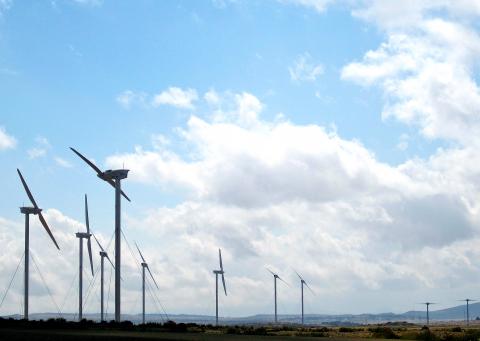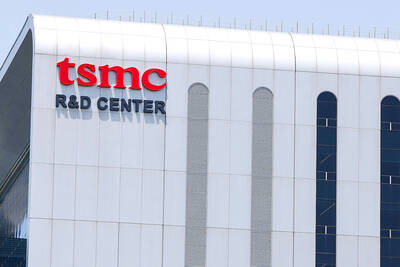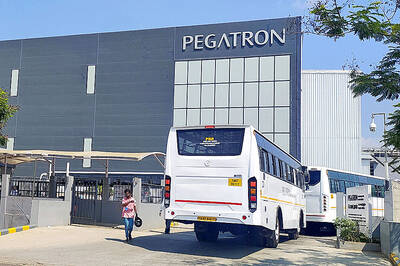Villagers in Ethiopia’s arid north live, as they have for centuries, surrounded by cattle and donkeys; only the rows of towering white wind turbines look out of place.
It is not the first place one might expect to find the sleek new structures. The unpaved roads around the site are lined with donkey-drawn carts lugging firewood and bushels of wheat.
“It’s a little bit anachronistic to see the turbines in a rural zone where peasants are working like they were centuries ago,” says Gerard Damongeot of the French-run Ashegoda wind farm.

Photo: AFP
However, he says, it is “very, very windy,” making it the perfect location for the turbines.
The path toward green power, however, is strewn with obstacles. The land taken up by the turbines was once used by local farmers. About 700 growers have lost either some or all of their land, according to Ethiopian Electric Power Corp (EEPCO) site manager Fisseha Gebremichael.
Local government provided compensation to affected farmers, but some say the payment was inadequate.
“We are not happy, we had good income from this land,” farmer Abraha Woldu said.
He was given US$4,000 for his one hectare of land, which he said was not enough to lease another plot. Like many Ethiopians, Abraha feels ambivalent about the wind farm. He welcomes progress, but is disappointed to have lost his main source of income.
“I am happy to develop my country, but I am not happy about the payment I received,” he said.
The Ashegoda wind farm, sub-Saharan Africa’s largest, is part of Ethiopia’s ambitious strategy to become the region’s leading producer of renewable energy.
The country is aiming for a seven-fold increase in renewable energy production in the next five years.
Ethiopian Prime Minster Meles Zenawi, the African Union’s special representative on the environment, pushed this month for countries to commit to green policies at UN climate talks in Durban, South Africa.
As part of Ethiopia’s ambitious US$150 billion, 20-year green-growth strategy, diesel power stations will be replaced by hydro, solar, geothermal and wind energy by 2015.
It is a bold plan. More than half of all Ethiopians do not have access to electricity and critics say the scale of the plans is unfeasible.
And while the majority of power produced at Ashegoda and elsewhere will connect to the national grid, it is even hoped to produce a surplus, with about 10 percent being sold to neighboring Djibouti, Kenya and Sudan, as well as to Egypt.
Run by France’s Vergnet Groupe, Ashegoda is the first of six planned wind farms in the country. With 30 of 84 wind towers erected since construction began in 2009, the plant expects the first megawatt of electricity to be produced by the end of this month.
Damongeot said the decision to work in Ethiopia was a fairly easy one. Corruption is much less of a problem than elsewhere on the continent and there is a genuine commitment to renewable energy.
And of course, there is an abundance of wind, the result of a varied terrain and access to Red Sea winds from the east, with the company constructing two more plots of turbines by the middle of next year.
However, the company does not expect to turn a profit from Ashegoda because of escalating costs. The US$282 million plan was financed by a loan from several French banks and the French development agency.
“We’ve lost a lot of money and we don’t expect to make any money,” Damongeot said, laughing.
However, he maintains it is a good opportunity for the company to establish itself in Ethiopia, where they may expand into hydro projects in the future.
For Fisseha, renewable energy is a key investment for a developing country like Ethiopia. They can avoid the environmental damage seen in Western countries and boost exports at the same time, he said.
“Ethiopia is developing and investing in such a way to be environmentally friendly and not make the mistakes of the developing world,” he said.
“We are trying, we are trying hard,” he added.
Ethiopian Water and Energy Minister Alemayehu Tegenu is optimistic the effort will pay off in a matter of years.
“You’ll find that all Ethiopians will have access to electricity — you’ll find every industry has a good supply of green, renewable energy,” he said. “And wind farms everywhere, of course.”

The Eurovision Song Contest has seen a surge in punter interest at the bookmakers, becoming a major betting event, experts said ahead of last night’s giant glamfest in Basel. “Eurovision has quietly become one of the biggest betting events of the year,” said Tomi Huttunen, senior manager of the Online Computer Finland (OCS) betting and casino platform. Betting sites have long been used to gauge which way voters might be leaning ahead of the world’s biggest televised live music event. However, bookmakers highlight a huge increase in engagement in recent years — and this year in particular. “We’ve already passed 2023’s total activity and

BIG BUCKS: Chairman Wei is expected to receive NT$34.12 million on a proposed NT$5 cash dividend plan, while the National Development Fund would get NT$8.27 billion Taiwan Semiconductor Manufacturing Co (TSMC, 台積電), the world’s largest contract chipmaker, yesterday announced that its board of directors approved US$15.25 billion in capital appropriations for long-term expansion to meet growing demand. The funds are to be used for installing advanced technology and packaging capacity, expanding mature and specialty technology, and constructing fabs with facility systems, TSMC said in a statement. The board also approved a proposal to distribute a NT$5 cash dividend per share, based on first-quarter earnings per share of NT$13.94, it said. That surpasses the NT$4.50 dividend for the fourth quarter of last year. TSMC has said that while it is eager

‘IMMENSE SWAY’: The top 50 companies, based on market cap, shape everything from technology to consumer trends, advisory firm Visual Capitalist said Taiwan Semiconductor Manufacturing Co (TSMC, 台積電) was ranked the 10th-most valuable company globally this year, market information advisory firm Visual Capitalist said. TSMC sat on a market cap of about US$915 billion as of Monday last week, making it the 10th-most valuable company in the world and No. 1 in Asia, the publisher said in its “50 Most Valuable Companies in the World” list. Visual Capitalist described TSMC as the world’s largest dedicated semiconductor foundry operator that rolls out chips for major tech names such as US consumer electronics brand Apple Inc, and artificial intelligence (AI) chip designers Nvidia Corp and Advanced

Pegatron Corp (和碩), an iPhone assembler for Apple Inc, is to spend NT$5.64 billion (US$186.82 million) to acquire HTC Corp’s (宏達電) factories in Taoyuan and invest NT$578.57 million in its India subsidiary to expand manufacturing capacity, after its board approved the plans on Wednesday. The Taoyuan factories would expand production of consumer electronics, and communication and computing devices, while the India investment would boost production of communications devices and possibly automotive electronics later, a Pegatron official told the Taipei Times by telephone yesterday. Pegatron expects to complete the Taoyuan factory transaction in the third quarter, said the official, who declined to be